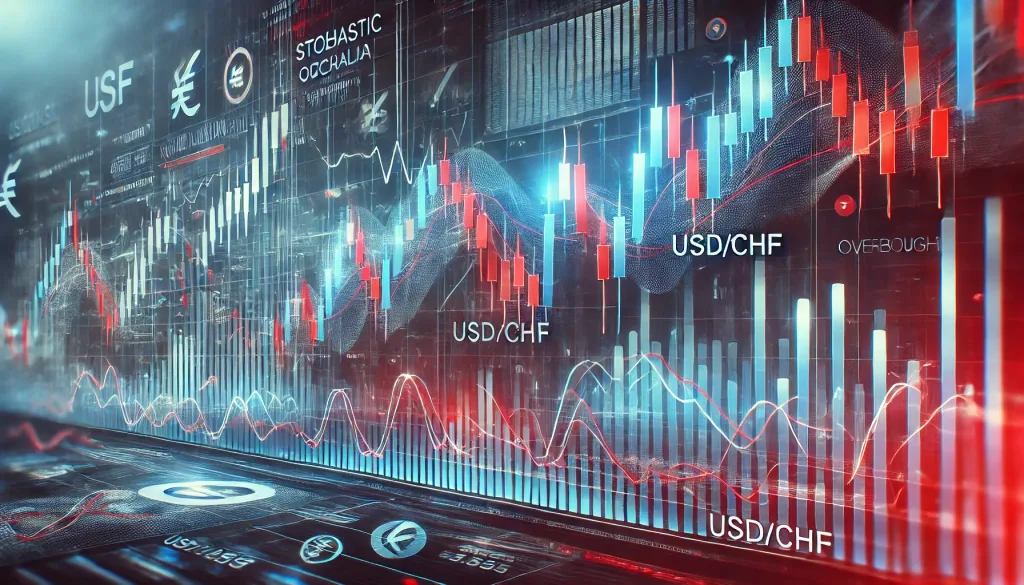The Stochastic Oscillator Secret: How to Master USD/CHF Like a Pro

Why Most Traders Get Stochastic Oscillator Wrong (And How to Fix It)
Picture this: You spot what seems to be a perfect setup on USD/CHF. The stochastic oscillator is screaming “Overbought!” You place a sell order, rub your hands in excitement… and then watch in horror as the price keeps going up like a never-ending escalator. Sound familiar?
That’s because most traders completely misuse the stochastic oscillator—and today, we’re going to fix that.
The Underground Truth About the Stochastic Oscillator
Most trading textbooks tell you that a stochastic oscillator above 80 means “overbought” and below 20 means “oversold.” But here’s the kicker: markets can stay overbought or oversold for much longer than your account can survive.
What most traders don’t realize is that the stochastic oscillator isn’t about calling reversals—it’s about momentum. The real pros use it in ways that your average trader wouldn’t even consider.
The Hidden Formula Experts Use
Instead of blindly selling when the stochastic is high, use these next-level strategies:
- Trade With the Trend, Not Against It
- When the market is trending up, don’t short just because the stochastic says “overbought.” Instead, wait for a pullback to the 50-level on the stochastic before entering a long trade.
- In a downtrend, apply the reverse: wait for a rally and a stochastic dip from 50 before shorting.
- Ditch the Default Settings (Here’s the Ninja Move)
- The default (14,3,3) stochastic setting is what everyone uses—so naturally, big players know how to manipulate it.
- Instead, use 5,3,3 for short-term setups or 21,9,9 for longer-term confirmation. This simple tweak alone will make you see USD/CHF moves differently.
- The “Double Dip” Entry Trick
- When the stochastic oscillator crosses below 20, then comes back up, that’s when the real opportunity begins.
- Conversely, when it crosses above 80 and then dips back down, a strong sell signal emerges.
How to Predict Market Moves with Precision
Let’s get real: USD/CHF is one of the trickiest pairs to trade because it’s heavily influenced by macroeconomics—Swiss Franc safe-haven flows, U.S. interest rates, and central bank policies.
Here’s how to combine stochastic signals with market sentiment:
- When USD/CHF is bullish:
- Look for stochastic to pull back to 40–50 (not 20) before re-entering a long position.
- Check U.S. interest rate news—if rates are expected to rise, the trend is likely strong.
- When USD/CHF is bearish:
- Wait for stochastic to hit 50 before shorting—not the overbought 80.
- Keep an eye on safe-haven flows—if the market is panicking, CHF will gain strength.
Case Study: Outsmarting the Market With Stochastic & USD/CHF
In 2023, when the U.S. Fed hinted at pausing rate hikes, USD/CHF started falling. Traders who used a stochastic “fakeout” strategy (waiting for the indicator to dip under 20 and then return above it) were able to ride a 300+ pip move.
One trader who followed this approach (let’s call him Dave) ignored the “oversold” panic, waited for the stochastic to confirm momentum, and entered long after the oscillator rebounded. The result? A high-probability trade that avoided unnecessary losses.
The Forgotten Strategy That Outsmarted the Pros
A little-known trick? Pair stochastic signals with the RSI:
- When stochastic and RSI BOTH confirm momentum, you have a killer entry.
- If stochastic signals a reversal but RSI disagrees, it’s likely a trap.
This simple technique has helped veteran traders filter out fake signals and increase their accuracy dramatically.
Elite Tactics: How to Master USD/CHF with Stochastic Like a Pro
- Use multiple timeframes:
- Stochastic signals on the 4H chart are more reliable than on the 15M chart.
- If the daily stochastic confirms the same trend, that’s your green light to go in.
- Combine it with Smart Money Concepts:
- Institutions love to push price beyond “obvious” stochastic signals to trap retail traders.
- Wait for a liquidity grab—then enter after the market wipes out weak hands.
Final Thoughts: Don’t Trade USD/CHF Without This
If you’ve been using the stochastic oscillator the “basic” way, it’s time to level up. Instead of taking every overbought/oversold signal, apply these underground strategies to actually trade like a pro.
Want even more exclusive insights and live strategies?
- Stay ahead with real-time Forex news: Forex News Today
- Master next-level techniques with free Forex courses: Forex Education
- Join our community of expert traders: StarseedFX Community
- Get a free trading plan that actually works: Free Trading Plan
—————–
Image Credits: Cover image at the top is AI-generated
PLEASE NOTE: This is not trading advice. It is educational content. Markets are influenced by numerous factors, and their reactions can vary each time.

Anne Durrell & Mo
About the Author
Anne Durrell (aka Anne Abouzeid), a former teacher, has a unique talent for transforming complex Forex concepts into something easy, accessible, and even fun. With a blend of humor and in-depth market insight, Anne makes learning about Forex both enlightening and entertaining. She began her trading journey alongside her husband, Mohamed Abouzeid, and they have now been trading full-time for over 12 years.
Anne loves writing and sharing her expertise. For those new to trading, she provides a variety of free forex courses on StarseedFX. If you enjoy the content and want to support her work, consider joining The StarseedFX Community, where you will get daily market insights and trading alerts.
Share This Articles
Recent Articles
The GBP/NZD Magic Trick: How Genetic Algorithms Can Transform Your Forex Strategy
The British Pound-New Zealand Dollar: Genetic Algorithms and the Hidden Forces Shaping Currency Pairs
Chande Momentum Oscillator Hack for AUD/JPY
The Forgotten Momentum Trick That’s Quietly Dominating AUD/JPY Why Most Traders Miss the Signal
Bearish Market Hack HFT Firms Hope You’ll Never Learn
The One Bearish Market Hack High Frequency Traders Don't Want You to Know The

